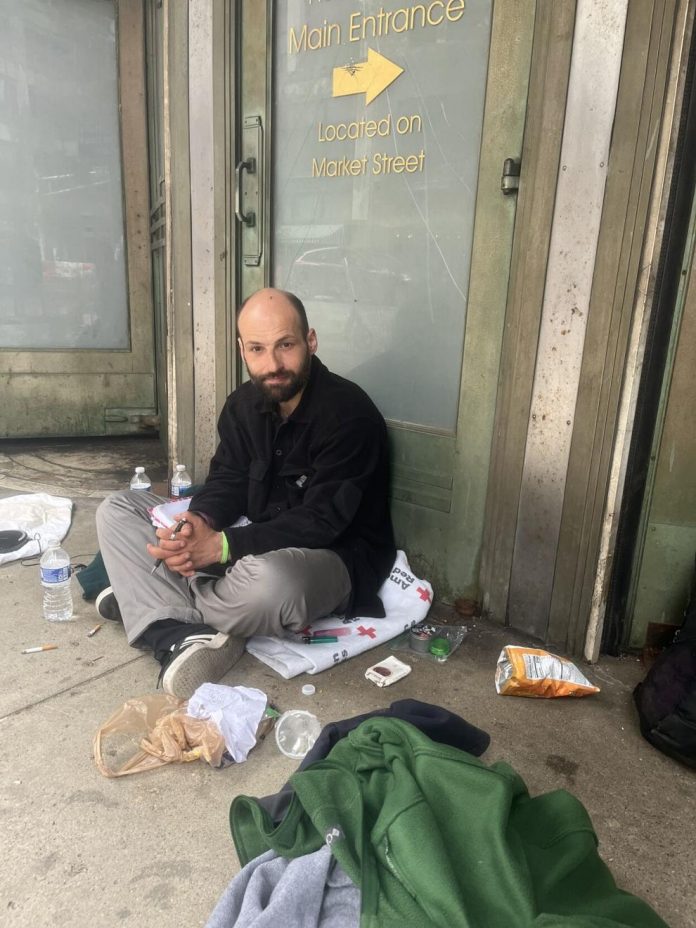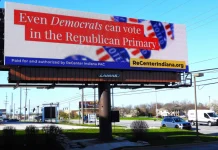Hoosiers Take Diverse Approach To Grow Affordable-Housing Crisis
- By Haley Carney, TheStatehouseFile.com.
 By Haley Carney, TheStatehouseFile.com.
By Haley Carney, TheStatehouseFile.com.People give dirty looks as they walk by, all of which he is far too used to receiving. Helton has been homeless since he was 17. He’s now 39.
He grew up in Indianapolis until his birth mother abruptly put him into foster care at 8 years old. While most of his childhood was spent in the system, he eventually got sent to drug rehab by a foster mom for smoking weed. Helton said weed is like a cigarette to him and he uses it to take the edge off, but it is not something he could quit even if he wanted to, especially now.
After getting out of rehab, Helton tried a halfway house but didn’t like it because of the small space, abundance of rules and cost.
“If you have an accident, all you have in your room is a bed and refrigerator. You have to walk all the way down the hall,” he said. “And rent was $350. I don’t want to pay rent.”
Helton said he would be even more reluctant to pay rent now with the continuously rising prices. According to Apartment List, the average cost of a one-bedroom apartment in Indianapolis is $1,212. This is a 13.7% rise since last year alone.
​After leaving the halfway house mostly due to cost, Helton decided to go back to the area he grew up and knew better than anywhere else: Eastside Indianapolis. This time, he had nowhere to go but was surprisingly content with that.
​“Having a home is a choice. Why would I want something that people are going to destroy again?” he said. “Once you get so old, you’re like, ‘Get an apartment, pay rent? F— you!’ Live under the sky, and you don’t have to pay anything.â€
​Helton is an anomaly, as homelessness is something he prefers. For some, it is their only option.
​The Coalition for Homelessness Intervention and Prevention (CHIP), along with the Indiana University Public Policy Institute’s Center for Research on Inclusion and Social Policy, releases results every year on the number of homeless individuals counted in Marion County. According to the report, homelessness was up 21% in 2021 from the previous year.
​Chief operator for Greater Indy Habitat for Humanity Ted Mosey works to lower those statistics. Mosey started as a volunteer for Habitat for Humanity (HFH) and said he saw firsthand the impact the organization can make and wanted to be a part of that lasting impression it leaves.
​HFH generally does not work with the homeless population but typically with families who are right on the cusp of it. These people are usually living paycheck to paycheck, paying more than 30% of their take-home pay towards housing.
​“On top of the issues with the housing market, we’re experiencing people coming to us from a bank who do get approved for a mortgage but for as low as $110,000. And it’s like, what are you going to do with that right now? Plus they’ll be approved for that then (get) charged as high as 5% interest,†said Mosey.
​According to Zillow, the average cost to buy a house in 2022 is $212,953. This is a large and rapid increase since 2019, when it was around $150,000.
​What most people don’t know is that HFH is also a mortgage company that originates and services all of its mortgages on its own. This is how it is able to keep them affordable. Mosey said when these people turn to HFH instead of other companies, HFH can offer a higher loan at 0% interest, which gives them many more options when buying.
But despite the organization’s best efforts in helping prevent homelessness, it is not always successful.
​Another option for those who struggle to afford housing payments is low-income housing. Across Indiana, according to the National Low Income Housing Coalition, there is a shortage of rental homes affordable and available to extremely low-income households whose incomes are at or below the poverty guideline or 30% of their area median income. Many of these households are severely cost burdened, spending more than half of their income on housing.
​Severely cost-burdened households are more likely than other renters to sacrifice other necessities like healthy food and health care to pay rent and to experience unstable housing situations (like evictions) that can lead to homelessness.
Franklin Community schoolteacher and church volunteer Christa Roberts told the story of a young anonymous woman (Jane Doe) in her late 40s who had been homeless and living on her own since she had left her parents’ house in high school.
​Doe had no identification, therefore was not accepted into shelters, forcing her to sleep outside most nights. After months of searching, Roberts and her church miraculously located Doe’s birth mother and father, who happened to live nearby. When church members showed up to their doorstep, the couple left them empty handed yet again, claiming they did not have any birth certificate, Social Security or other form of identification for their daughter.
​Although the church did eventually secure identification for Doe, Roberts said the task was just short of impossible. Unfortunately, that is the case for many homeless Hoosiers.
​“The odds are really stacked against people who don’t already have a stable home environment,†she said. “I think we all can agree that everyone thinks homelessness is something to not be ignored. The difference is how to help them all.â€
​After receiving the proper identification, Roberts and her church were able to get Doe into a shelter and eventually find her a job. However, a shelter is only one aspect of the overall issue of homelessness.
​Dennis Towles, community engagement manager for Wheeler Mission, said his organization provides a safe space for those experiencing homelessness to give them the opportunity to break the cycle of poverty in their lives.
​“There are an estimated 2,000 homeless in Indianapolis on any given night, and Wheeler facilities routinely will house close to 1,000 of those people, … men, women and children,†he said. “In that effort, we strive to return their joy and hope in the lives of those we meet.â€
​Not only does Wheeler Mission offer the homeless population shelter but also free meals, addiction recovery, help finding jobs and long-term residential programs.
​Towles said the Indy community is already struggling with high eviction rates and the growing impact of gentrification—the more affluent moving into urban areas, raising property values and displacing poorer families. He said there are now also fewer units to rent in less desirable areas and a bit of landlord fatigue due to some of the policies placed on them during COVID-19.
​However, Towles said community efforts toward housing have at least been somewhat successful in the trying times of the housing market.
​“In many situations, those in need of true supportive housing have been left still in need of true supportive housing. [But] thankfully, this is a need Wheeler is meeting on a small but growing scale,†said Towles. “All people deserve dignity, and all people deserve a chance. It’s the Hoosier spirit. We just want to lend a hand.â€
​While that hand is greatly appreciated by most in a situation like this, Helton politely denies the help that anyone offers him. He is living proof that the experiences of the homeless are unique from one individual to the next.
​Helton said one of his friends who lives near his childhood home persistently tries to find him housing, but he does not like staying anywhere except under the stars. This includes shelters, treatment facilities, prisons, jails, or any other cheap or free institutions and organizations.
​“If it rains, just find a roof. That’s all you need,†he said. “I always wanted to be a fireman when I grew up. I liked helping people, but I don’t want their help. I just want to do my own thing.â€
Haley Carney, formerly a reporter for TheStatehouseFile.com, recently graduated from Franklin College’s Pulliam School of Journalism. This report on Indiana’s affordable housing crisis was completed as part of her senior project.








Before it was unacceptable to hurt anyones feelings with truthful words, Mr. Helton would be known as a “bum”. Odd that the author doesn’t refer to Mr. Helton’s source of income that affords him to exist as he desires…”under the stars”.
The author’s other example, Jane Doe, he describes as a young woman in her late 40s. Perhaps he should have a better grasp on the relative meaning of “young” when describing a fellow human being.
How anything in the lives of these two can be relative to the affordable housing problem is highly doubtful. Better to have found a family down on their luck as an example for his article, which certainly wouldn’t have been in these times, but perhaps that wasn’t his intent.
Comments are closed.